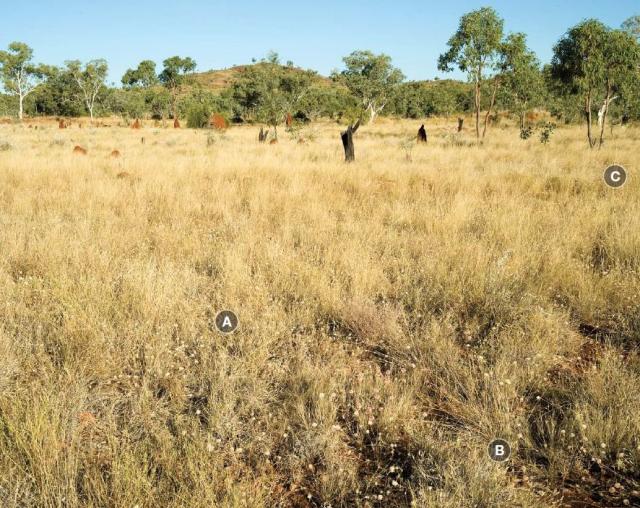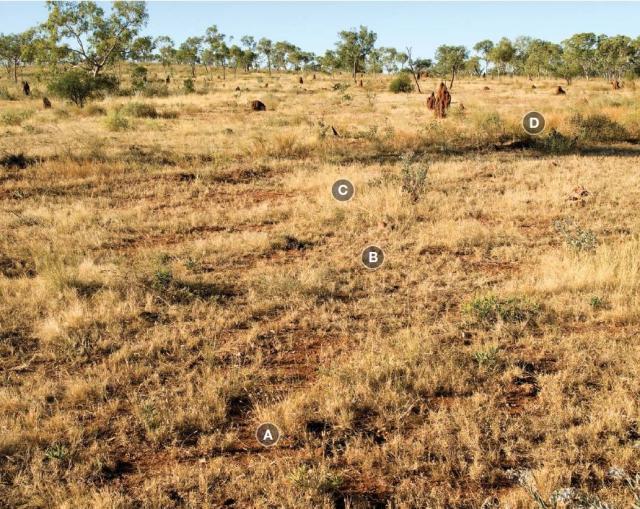Arid short grass pastures
These pastures are part of the Kimberley red soil group - not spinifex pastures, and limestone grasses are the identifier grasses. Use the interactive key to pasture condition to help identify pasture type.
Pastoral value
Evidence suggests that many arid short grass pastures are capable of supporting healthy stands of perennial grasses more characteristic of ribbon grass pasture, if spelled to allow recovery. Ribbon grass pasture is a more-resilient and more-productive pasture type than arid short grass pasture.
Pastoral value for arid short grass pasture is moderate, but resilience is low. Though annual grasses, such as limestone grass and Kimberley couch, can provide good feed for livestock early in the year while still green, their bulk is variable. In below-average rainfall years, very little annual grass may be produced.
The small patches of the long-lived perennial grasses supply the bulk of the feed for the rest of the year. Limestone grass and some other robust annual grasses can act as short-lived perennials under optimal conditions (a run of good seasons).
Occurrence
Arid short grass pastures are grasslands dominated by short-lived perennial or annual grasses with scattered eucalypt trees. They occur on level to undulating plains. Soils are variable depth loams (sometimes calcareous) and the surface may be stony. The occurrence of these pastures is often the result of a transition within ribbon grass pastures following sustained overgrazing.
Pasture condition
Good: Limestone grass is usually dominant when this pasture type is in good condition. Purple nineawn, an intermediate annual grass, may also be common. Plants are robust and vigorous, and bare ground is minimal unless pasture is grazed down (Figure 1).
Some perennial grasses, such as ribbon grass, wire grass, white grass and black speargrass, may be present as sparse, isolated plants or scattered small patches.

Fair: As pasture condition declines from good to fair, intermediate annual grasses, such as bunched kerosene grass, become more common. Limestone grass is still prominent, although the plants are likely to be less vigorous and bare areas may be visible (Figure 2).
Less-palatable perennial species, such as wire grass, white grass and black speargrass, may still persist.

Poor: Further decline towards poor condition is signalled by large areas of bare ground and increased presence of unpalatable annual grasses, such as threeawns. Remaining perennial grasses are much reduced in vigour. In areas adjacent to hard spinifex pastures, hard spinifex may colonise the bare areas (Figure 3).

Associated plants
| Common name (link to DPIRD species page) | Scientific name (link to FloraBase) | Life form |
|---|---|---|
| Desirable species | ||
| annual or short-lived perennial | ||
| Perennial lovegrasses | Eragrostis spp. | perennial grasses |
| perennial grass | ||
| perennial grass | ||
| perennial grass | ||
| Intermediate species | ||
| Purple nineawn | annual or short-lived perennial | |
| Kimberley couch | annual grass | |
| annual or short-lived perennial | ||
| Wire grass, northern Wanderrie grass | perennial grass | |
| perennial grass | ||
| annual grass | ||
| annual or short-lived perennial | ||
| Undesirable species | ||
| annual or short-lived perennial grass | ||
| Northern kerosene grass | annual grass | |
| Unequal threeawn, feathertop threeawn | perennial grass | |
| Winged spinifex, lobed spinifex | perennial grass | |
| Limestone spinifex | perennial grass |


